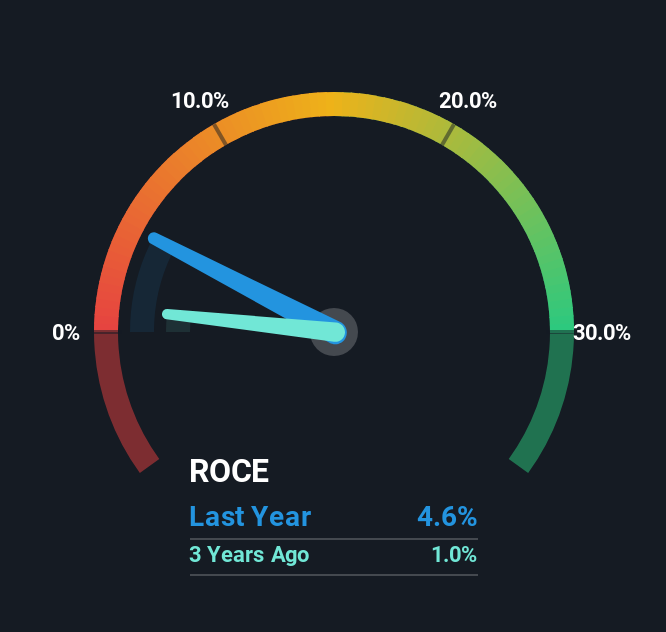- Israel
- /
- Construction
- /
- TASE:RPAC
The Return Trends At Rapac Communication & Infrastructure (TLV:RPAC) Look Promising
To find a multi-bagger stock, what are the underlying trends we should look for in a business? Firstly, we'd want to identify a growing return on capital employed (ROCE) and then alongside that, an ever-increasing base of capital employed. Ultimately, this demonstrates that it's a business that is reinvesting profits at increasing rates of return. Speaking of which, we noticed some great changes in Rapac Communication & Infrastructure's (TLV:RPAC) returns on capital, so let's have a look.
Return On Capital Employed (ROCE): What Is It?
For those that aren't sure what ROCE is, it measures the amount of pre-tax profits a company can generate from the capital employed in its business. To calculate this metric for Rapac Communication & Infrastructure, this is the formula:
Return on Capital Employed = Earnings Before Interest and Tax (EBIT) ÷ (Total Assets - Current Liabilities)
0.046 = ₪50m ÷ (₪1.6b - ₪475m) (Based on the trailing twelve months to June 2025).
Thus, Rapac Communication & Infrastructure has an ROCE of 4.6%. In absolute terms, that's a low return and it also under-performs the Construction industry average of 7.0%.
See our latest analysis for Rapac Communication & Infrastructure

Historical performance is a great place to start when researching a stock so above you can see the gauge for Rapac Communication & Infrastructure's ROCE against it's prior returns. If you're interested in investigating Rapac Communication & Infrastructure's past further, check out this free graph covering Rapac Communication & Infrastructure's past earnings, revenue and cash flow.
So How Is Rapac Communication & Infrastructure's ROCE Trending?
Even though ROCE is still low in absolute terms, it's good to see it's heading in the right direction. The figures show that over the last five years, returns on capital have grown by 122%. That's not bad because this tells for every dollar invested (capital employed), the company is increasing the amount earned from that dollar. Speaking of capital employed, the company is actually utilizing 35% less than it was five years ago, which can be indicative of a business that's improving its efficiency. A business that's shrinking its asset base like this isn't usually typical of a soon to be multi-bagger company.
For the record though, there was a noticeable increase in the company's current liabilities over the period, so we would attribute some of the ROCE growth to that. Effectively this means that suppliers or short-term creditors are now funding 30% of the business, which is more than it was five years ago. It's worth keeping an eye on this because as the percentage of current liabilities to total assets increases, some aspects of risk also increase.
The Key Takeaway
From what we've seen above, Rapac Communication & Infrastructure has managed to increase it's returns on capital all the while reducing it's capital base. And a remarkable 208% total return over the last five years tells us that investors are expecting more good things to come in the future. So given the stock has proven it has promising trends, it's worth researching the company further to see if these trends are likely to persist.
On a final note, we've found 1 warning sign for Rapac Communication & Infrastructure that we think you should be aware of.
For those who like to invest in solid companies, check out this free list of companies with solid balance sheets and high returns on equity.
New: AI Stock Screener & Alerts
Our new AI Stock Screener scans the market every day to uncover opportunities.
• Dividend Powerhouses (3%+ Yield)
• Undervalued Small Caps with Insider Buying
• High growth Tech and AI Companies
Or build your own from over 50 metrics.
Have feedback on this article? Concerned about the content? Get in touch with us directly. Alternatively, email editorial-team (at) simplywallst.com.
This article by Simply Wall St is general in nature. We provide commentary based on historical data and analyst forecasts only using an unbiased methodology and our articles are not intended to be financial advice. It does not constitute a recommendation to buy or sell any stock, and does not take account of your objectives, or your financial situation. We aim to bring you long-term focused analysis driven by fundamental data. Note that our analysis may not factor in the latest price-sensitive company announcements or qualitative material. Simply Wall St has no position in any stocks mentioned.
About TASE:RPAC
Rapac Communication & Infrastructure
Engages in trade commerce, electrical projects, government, and electricity production businesses in Israel.
Flawless balance sheet with acceptable track record.
Similar Companies
Market Insights
Community Narratives



